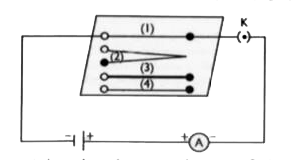What is electrical resistivity of a material? What is its unit? Describe an experiment to study the factors on which the resistance of conducting wire depends.Solution in Kannada
The electrical resistivity of a material is defined as the resistance of a conductor made of that material of unit length and unit cross-sectional area. Its SI unit is Ohm metre [Ωm]
R=ρlA→ρ=RAl
[where, A=2m2/l=1m]
Consider an electric circuit consisting of a cell, an ammeter, a nichrome wire of length L [marked I to 4] and a plug key as shown below

Plug the key and note the current in the ammeter. Replace the nichrome wire by another nichrome wire of same thickness but twice the length that is 2l at point 2. Again note the reading. Now, replace the wire by a thicker nichrome wire of same length [marked 3]. A thicker wire has a larger cross-sectional area. Again note down the current through the circuit. Replace nichrome wire with copper wire of same length and same area of cross-section at point 4, Note the value of current. Notice the difference in the current in all cases. When the length of the wire is doubled, then the ammeter reading decreases to half its previous value i.e., current through the wire is halved. Since, resistance of the wire R = V/I, then R is doubled which implies R (prop) L [Use proportional symbol]. When the nichrome wire is replaced by a thicker one of same material and length, the current in the wire increases which means that the resistance of the thicker wire [3] is less than that of the thinner wire [l]. This implies R proportional to 1/A where A is area of cross section of the wire. When the nichrome wire is replaced by a copper wire [4] of the same length and same cross-sectional area, then the current recorded by the ammeter is more. This means that the resistance of copper wire is less than that of the nichrome wire of the same dimensions i.e. the resistance of the wire depends on the nature of its material.
Topper's Solved these Questions
- ELECTRICITYBOOK - ZEN PUBLICATIONCHAPTER - ELECTRICITYEXERCISE - ZEN ADDITIONAL QUESTIONS SECTION (MULTIPLE CHOICE QUESTIONS)
60 Videos
- ELECTRICITYBOOK - ZEN PUBLICATIONCHAPTER - ELECTRICITYEXERCISE - ZEN ADDITIONAL QUESTIONS SECTION (SHORT ANSWER TYPE 2 QUESTIONS)
24 Videos
- LIGHT - REFLECTION AND REFRACTIONBOOK - ZEN PUBLICATIONCHAPTER - LIGHT - REFLECTION AND REFRACTIONEXERCISE - ZEN ADDITIONAL QUESTIONS SECTION (LONG ANSWER [LA] QUESTIONS)
30 Videos
Similar Questions
A cell, a resistor, a key and ammeter are arranged as shown in the circuit diagrams. The current recorded in the ammeter will be

View SolutionThree 2Ω resistors, A, B and C, are connected as shown in figure. Each of them dissipates energy and can withstand a maximum power of 18 W without melting. Find the maximum current that can flow through the three resistors?

View SolutionDraw ray diagrams showing the image formation by a concave mirror when an object is placed.
(a) between pole and focus of the mirror
(b) between focus and centre of curvature of the mirror
(c ) at centre of curvature of the mirror
(d) a little beyond centre of curvature of the mirror
(e ) at infinity
View SolutionOn what factors does the resistivity of a material depend ?
View Solutionविद्युत् प्रतिरोध को परिभाषित कीजिए । किसी चालक पर विद्युत् प्रतिरोध किन-किन कारकों पर निर्भर करता है ?
View Solutionकिसी तार का प्रतिरोध किन-किन कारकों पर निर्भर करता है?
View SolutionAssertion (A): Bending of a conducting wire effects electrical resistance.
Reason( R): Resistance of a wire depends on resistivity of that material.
View Solutionविद्युत प्रतिरोधकता को परिभाषित कीजिए। इसका S.I. मात्रक लिखिए।प्रतिरोधकता किन भौतिक कारकों पर निर्भर करती है?
View SolutionOn which factors does the resistivity of conducting wire depends?
View SolutionOn which factors does the resistance of a conducting wire depends?
View SolutionWhat is electrical resistance ? Its value depend on which factors ?
View SolutionWhat is resistance of a wire ? What are the factors on which resistance of a conductor depends?
View SolutionOn which factors does the resistivity of a conducting wire depend?
View Solutionकिसी पदार्थ की वैद्युत प्रतिरोधकता से क्या तात्पर्य है? इसका क्या मात्रक है? किसी चालक तार के प्रतिरोध को प्रभावित करने वाले कारकों का अध्ययन करने के लिए किसी प्रयोग का वर्णन कीजिए।
View SolutionWhat is electrical resistivity of a material? What is its unit? Describe an experiment to study the factors on which the resistance of conducting wire depends.
View Solution
